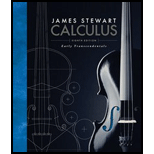
Concept explainers
In an elementary chemical reaction, single molecules of two reactants A and B form a molecule of the product C: A + B → C. The law of mass action states that the rate of reaction is proportional to the product of the concentrations of A and B:
(See Example 3.7.4.) Thus, if the initial concentrations are [A] = a moles/L and [B] = b moles/L and we write x = [C], then we have
(a) Assuming that a ≠ b, find x as a function of t. Use the fact that the initial concentration of C is 0.
(b) Find x(t) assuming that a = b. How does this expression for x(t) simplify if it is known that
Want to see the full answer?
Check out a sample textbook solution
Chapter 9 Solutions
Calculus: Early Transcendentals
- x-4 Let f(x)=5x-1, h(x) = Find (fo h)(0). 3 (fo h)(0) = (Type an integer or a fraction.)arrow_forwardFill in the blanks to write the calculus problem that would result in the following integral (do not evaluate the interval). Draw a graph representing the problem. π/2 So/² 2xcosx dx Find the volume of the solid obtained when the region under the curve 38,189 on the interval is rotated about the axis.arrow_forwardLet f(x) = -5x-1, g(x) = x² + 5, h(x) = · x+4 3 Find (hog of)(1). (hogof)(1)= (Simplify your answer. Type an integer or a decimal.)arrow_forward
- For the given function, find (a) the equation of the secant line through the points where x has the given values and (b) the equation of the tangent line when x has the first value. y= f(x) = x²+x; x=-1,x=2 a. Which of the following formulas can be used to find the slope of the secant line? ○ A. 2-(-1) f(2) f(-1) 2+(-1) C. 1(2)+(-1) The equation of the secant line is 1(2)+(-1) О в. 2+(-1) f(2)-(-1) D. 2-(-1)arrow_forwardplease do not use chat gptarrow_forwardUse technology to find f'(4), f'(16), f'(-5) for the given function when the derivative exists. f(x) = -2x² + +10xarrow_forward
- Good Day, Kindly assist me with the following query. Any assistance would be appreciated.arrow_forwardCan u give rough map of any room u can choose cm on toparrow_forward3. We'd like to know the first time when the population reaches 7000 people. First, graph the function from part (a) on your calculator or Desmos. In the same window, graph the line y = 7000. Notice that you will need to adjust your window so that you can see values as big as 7000! Investigate the intersection of the two graphs. (This video shows you how to find the intersection on your calculator, or in Desmos just hover the cursor over the point.) At what value t> 0 does the line intersect with your exponential function? Round your answer to two decimal places. (You don't need to show work for this part.) (2 points)arrow_forward
- Algebra & Trigonometry with Analytic GeometryAlgebraISBN:9781133382119Author:SwokowskiPublisher:Cengage
 Linear Algebra: A Modern IntroductionAlgebraISBN:9781285463247Author:David PoolePublisher:Cengage Learning
Linear Algebra: A Modern IntroductionAlgebraISBN:9781285463247Author:David PoolePublisher:Cengage Learning


